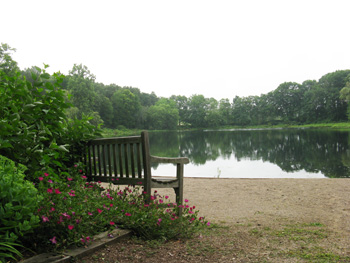Column: Seeds & Stems
If you like going touring other people’s gardens – especially because someone else is doing all the work – you’ll love Hidden Lake Gardens.
They’ve got a guy who mows the lawns full time, along with a couple of part-timers. They’ve got people on their staff who can move a full-grown tree in less than half an hour. They’ve got volunteers who help weed and dig and plant, all so you can take the time to literally stop and smell whatever flower is currently blooming.
There are acres of displays, including an extensive collection of dwarf and rare conifers, a hillside of hostas, and the requisite annuals and perennials, along with a tidy conservatory and miles of trails. If you bring your lunch (yes, there are picnic areas) and some bug spray, you’ll be able to spend the day looking at plants, listening to the birds and appreciating the swaths of lawn that someone else has to mow.
“Our mission is the enjoyment and education of the public,” says Steve Courtney, who manages the site for Michigan State University, “and enjoyment is first.”
Courtney recently gave me a guided tour of the grounds. Located west of Tipton, in Lenawee County, Hidden Lake Gardens is at least a 40-minute drive from Ann Arbor (if you can avoid any backups at the construction on M-52, south of I-94). But if it were any closer, it wouldn’t be the quiet hideaway I found when I went to visit last week.
Hidden Lake Gardens is run by Michigan State University, the state’s center of all plant knowledge. Why it is so far from MSU’s East Lansing campus makes sense only when you find out that that’s where Harry Fee chose to live more than 80 years ago.
Fee’s family made its money in utilities, and in 1926 Fee took his share, intending to retire to the countryside. He wanted property with a lake, and Hidden Lake fit the bill. It’s a natural kettle lake, the result of glacial formations eons ago, with a depth of about 65 feet. (Fee had his sailboat sunk in the lake for some reason unknown, and Courtney says it’s down there still.)
The property is located in the Irish Hills, so it includes some interesting geological features, including two other kettle lakes and a kame – a moundlike structure of loose soils left by a glacier.
Fee’s first plan was to become a gentleman farmer. That didn’t work out, so he decided to go into nursery plants. When the Depression hit in the ’30s, Fee decided he wouldn’t compete with local nurseries, and he’d just grow plants.
He was no landscaper. There is no design or plan for this site, which Fee said was simply developed as he went along. So, you still will find nursery stock, like the two hillsides of vinca – properly labeled – as you drive along.
Fee’s idea was to set up a series of “scenic pictures” for people to appreciate. He put in a road that went around the lake and up onto Juniper Hill. You can still drive up there today and see the wildflowers, the junipers and conifers along the lower edge.
In 1945, Fee donated the property to what was then Michigan State College, though he was still a figure in the development of the property until his death in 1954. Over the years, MSU has added to the property, and today’s Hidden Lake Gardens include 755 acres.
An estimated 50,000 people visit the grounds every year, but when I was out there on a weekday, I had the place pretty much to myself. It is the perfect place to hide away.
There’s the conservatory with a display of bonsai just outside. A colorful demonstration garden is filled with perennials. There are collections of ginkos and maples. (But don’t look for the ash collection, which nowadays is only a collection of dead tree trunks, courtesy of the emerald ash borer invasion.)
If your Aunt Minnie loves gardens, but is in no shape to hike into the back 40, it’s not a problem. You can drive her to the top of Juniper Hill to see the view. The road passes right next to the hosta garden, where she’ll only have to walk a few steps.
Hosta fans probably have already seen the garden at Hidden Lake Gardens, which was set up along one edge of Hidden Lake on the site of Fee’s original rock garden.
The Michigan Hosta Society planted the garden and takes care of the 800 or so cultivars, says Courtney. The thing to appreciate is not some rare hosta – there are none, he says – but to see the variety of plants, including some from hybridizers.
And don’t miss the Harper Collection of Dwarf and Rare Conifers, which Courtney rates as the best in North America. (If he’s pushed, he admits it’s the best if you count South America, too.)
In 2012, the collection is set to host the national meeting of the American Conifer Society. The only problem is finding the closest hotel to put them in, says Courtney, who is on the society’s board. It might not be the worst thing in the world for them to camp out there.
Even if you’re not an expert in conifer taxonomy, you can sit in a tidy gazebo and smell the junipers in the collection, which includes the towering snake spruce and the weeping Japanese larch. There is the Cedar of Lebanon, which shouldn’t even be growing in this climate, says Courtney. “The first five years, it lost every one of its needles,” he says. Now, it’s flourishing.
There are trees that light up the landscape, and some unusual specimens – genetic oddities that look like two different trees growing as one.
The collection was started in the 1980s with trees from Justin “Chub” Harper, who donated his conifer collection when it got too big for his backyard in East Moline, Ind.
Harper, who died in March 2009, was the kind of collector whose interest jumped from roses to day lilies. Then he found conifers, filling his own yard and that of his neighbors. In 1980, MSU staff headed over to Harper’s house and loaded three tractor trailers with 351 trees to start the collection.
Some of those original conifers are still in the collection, but trees are added and subtracted to the collection all the time, says Courtney. Twice a year, decisions are made on whether to keep a specimen or “send it for a short trip on the chipper truck,” he says.
Maybe that’s why those conifers look so good – even lush, if you can use that word to describe a pine tree. But if you start to wonder why your arborvitae can’t look this good, consider the fact that every autumn the Hidden Lake Gardens staff put up an electrified fence around the conifer collection and around the trees on Juniper Hill to thwart the deer looking for a breakfast, lunch or dinner.
And consider that Hidden Lake Gardens runs with a staff (including the mowers) of six full-timers and about 25 seasonal workers, as well as a number of volunteers who run the gift shop and do some of the gardening. The gardens’ budget is about $1 million, Courtney says, and that includes endowments for the hosta and conifer collections. The rest comes from donations, whatever comes in with the $3 entry fee and things like copyright payments for two kinds of trees. MSU is on the hook for Courtney’s salary and infrastructure, such as taking care of the roadways.
The gardens might not be too close to East Lansing, but it is not forgotten. When MSU horticulturists find they’ve got too many trees around, they might move them over to Hidden Lake Gardens. They’re also working on some new shrub specimens and on cultivating some of the trees with interesting characteristics that are already on the grounds.
And there is other research going on. In the past, a drug company used trees on the ground in their study of the breast cancer drug Taxol, says Courtney. Currently, traps have been set out to see if a new insect pest, the sirex woodwasp, has made it into the area.
Though last week was the first time I’d been to Hidden Lake Gardens, I’ve resolved to come back in the spring to see the corridor of crabapples and lilacs blooming. In the fall, I want to see the colors on the sweet gum and the tupelo trees by the conservatory. And there are a number of sassafras and maples – Mr. Fee had one grove of sugar maples, now towering over everything else, specifically planted in the woods.
And winter will be the time to really see those conifers again.
For Something Completely Different: Dead Beetle Giveaway
The only people who don’t hate Japanese beetles are people who have never had them around.
The iridescent green-and-brown bugs look kind of interesting – until you see hundreds, or even thousands of them, on the plants in your yard doing the two things they have evolved to do: Eating the leaves and, let’s say, reproducing.
Here’s your chance for revenge.
On Wednesday, July 28, Michigan State University will be giving away bags of frozen Japanese beetles, an estimated 15-20% of them infected with the protozoan pathogen Ovavesicula popilliae. You don’t have to pronounce it, you just have to know that MSU entomologist David Smitley has been studying it for years and found it effective in cutting the Japanese beetle population.
The frozen bug giveaway will be from 10 a.m.-noon at MSU’s Tollgate Research and Extension Farm near Novi. At 10 a.m., 10:30 a.m. and 11 a.m., there will be talks on the Japanese beetle project, then everyone will get a bag with about 50 of the freshly frozen bugs. You get to take them home and put them in your own yard to help establish the pathogen in the soil. (Go online for more details about this event.)
The pathogen doesn’t kill Japanese beetles; it just weakens them so that, for example, an infected female will not lay eggs.
Brought here from Connecticut, the pathogen infects only Japanese beetles, not people, pets or other insects, Smitely said. His biggest worry is that he’ll have more than the expected number of Japanese beetle haters.
About two years ago, he had a similar giveaway on a golf course south of Detroit and ran out of the infected insects. The people who went away bug-less were not happy, Smitley said when I talked to him a few days ago. “They were mad,” he said. “They were really mad.”
So get in line early. I plan to be there too, to get me some of those frozen beetles. Once again proving that revenge – even on bugs – is best served cold.
About the writer: Marianne Rzepka, former reporter for the Ann Arbor News and Detroit Free Press, is a Master Gardener who lives in Ann Arbor and thinks it’s fun to turn the compost pile.








Thank you Marianne for a wonderful article about a wonderful place in our state. I discovered Hidden Lake about three years ago and it is one of my favorite annual day trips for my family and I. Its a real gem and I only wish more people knew about it. Its one place I plan to take my family when they visit from other parts of the US.
I haven’t been there for a while, but a favorite was the primrose path near the lake – blooms in June.